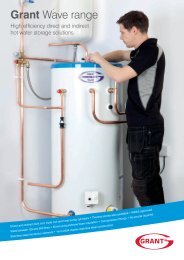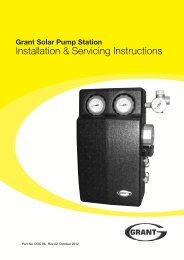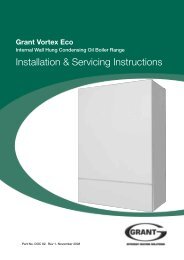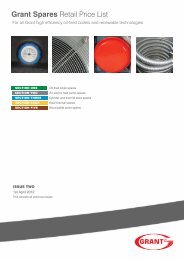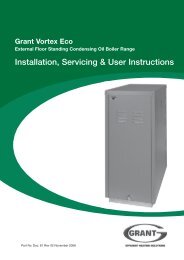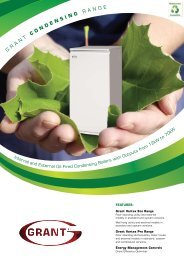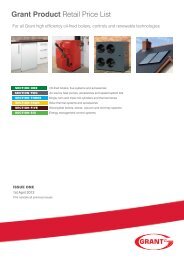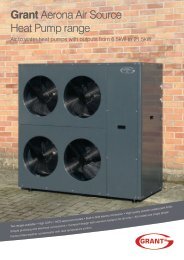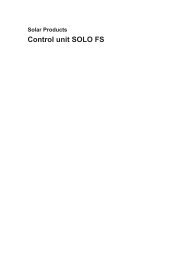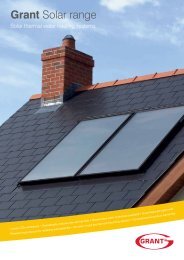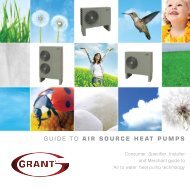Installation & Servicing Instructions - Grant UK
Installation & Servicing Instructions - Grant UK
Installation & Servicing Instructions - Grant UK
Create successful ePaper yourself
Turn your PDF publications into a flip-book with our unique Google optimized e-Paper software.
6User <strong>Instructions</strong><br />
Frost Protection<br />
Your Installer may have fitted a frost<br />
thermostat. If not, and you are likely to<br />
be away for a short time, leave the boiler<br />
on with the boiler thermostat set at a low<br />
setting. For longer periods the boiler and<br />
system should be drained.<br />
Contact your Service engineer for<br />
draining and filling the system.<br />
The control panel of the External module<br />
includes a built-in frost thermostat<br />
factory set to 2°C.<br />
!<br />
We recommend that both antifreeze<br />
and corrosion inhibitor be used in the<br />
primary water system.<br />
Cleaning and <strong>Servicing</strong><br />
Lightly wipe over the case with a damp<br />
cloth and a little detergent. Do not use<br />
abrasive pads or cleaners.<br />
You must have your boiler serviced at<br />
least once a year to ensure safe and<br />
efficient operation. Contact your Service<br />
engineer for further details.<br />
!<br />
NOTE<br />
WARNING<br />
External equipment operated at<br />
230 volts should not be serviced<br />
or repaired under adverse weather<br />
conditions.<br />
Sealed Central Heating System<br />
If your boiler is operating on a sealed<br />
heating system, the installer will have<br />
pressurised the system and should<br />
have told you (or set it on the pressure<br />
gauge) the system pressure when cold<br />
(this is normally between 0.5 and 1.0<br />
bar, which will increase slightly when<br />
hot). If the pressure (when cold) is below<br />
the set pressure mentioned above, you<br />
can re-pressurise the system. If this is<br />
frequently required, ask your Installer or<br />
Service engineer to check the heating<br />
system for leaks and to check the<br />
expansion vessel air charge.<br />
The boiler or system will be fitted with an<br />
automatic air vent to remove air from the<br />
system. Any air trapped in the radiators<br />
should be removed by venting the<br />
radiators using the vent screw at the top<br />
of each radiator. Only vent a radiator if<br />
the top is cool and the bottom is hot.<br />
Excessive venting will reduce the system<br />
pressure, so only vent when necessary<br />
and check the system pressure as<br />
mentioned above.<br />
Re-pressurise the system if necessary.<br />
The sealed system is fitted with<br />
a safety valve to release excess<br />
pressure from the system. If water or<br />
steam is emitted from the end of the<br />
safety valve discharge pipe, switch off<br />
the boiler and contact your Installer or<br />
Service engineer.<br />
To re-pressurise the system by adding<br />
water:<br />
1. Only add water to the system when<br />
it is cold and the boiler is off. Do not<br />
overfill.<br />
2. Ensure the flexible filling loop (see<br />
Figure 3) is connected and that the<br />
shut off valve connecting it to the<br />
boiler is open and the double check<br />
valve at the front is closed. (A valve<br />
is open when the operating lever is in<br />
line with the valve, and closed when<br />
it is at right angles to it).<br />
3. Gradually open the double check<br />
valve on the front of the filling loop<br />
until water is heard to flow. When the<br />
black needle of the pressure gauge<br />
is between 0.5 and 1 bar, close the<br />
valve.<br />
4. Vent each radiator in turn, starting<br />
with the lowest one in the system, to<br />
remove air.<br />
5. Continue to fill the system until the<br />
pressure gauge indicates between<br />
0.5 and 1.0 bar. Close the fill point<br />
valve.<br />
6. Repeat steps 4 and 5 as required.<br />
7. Close the valves either side of the<br />
filling loop and disconnect the loop.<br />
Failure of Electricity Supply<br />
If the electricity supply fails, the boiler<br />
will not operate. It should relight<br />
automatically when the supply is<br />
restored.<br />
Electricity Supply<br />
The boiler requires a 230/240 V ~ 50 Hz<br />
supply. It must be protected by a 5 Amp<br />
fuse.<br />
!<br />
WARNING<br />
The electricity connections to the<br />
boiler must be earthed.<br />
Figure 3: Sealed system filling loop arrangement



